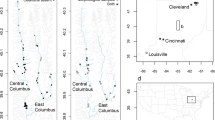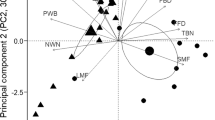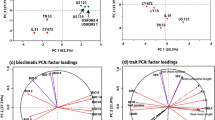Abstract
Both phenotypic plasticity and locally adapted ecotypes may contribute to the success of invasive species in a wide range of habitats. Here, we conducted common garden experiments and molecular marker analysis to test the two alternative hypotheses in invasive alligator weed (Alternanthera philoxeroides), which colonizes both aquatic and terrestrial habitats. Ninety individuals from three pairs of aquatic versus terrestrial populations across southern China were analyzed, using inter simple sequence repeat (ISSR) marker, to examine population differentiation in neutral loci. Two common gardens simulating aquatic and terrestrial habitats were set up to examine population differentiation in quantitative traits. We found no evidence of population differentiation in both neutral loci and quantitative traits. Most individuals shared the same ISSR genotype. Meanwhile, plants from different habitats showed similar reaction norms across the two common gardens. In particular, plants allocated much more biomass to the belowground roots in the terrestrial environment, where alligator weed may lose part or all of the aboveground shoots because of periodical or accidental disturbances, than those in the aquatic environment. The combined evidence from molecular marker analysis and common garden experiments support the plasticity hypothesis rather than the ecotype hypothesis in explaining the adaptation of alligator weed in a wide range of habitats.
Similar content being viewed by others
Abbreviations
- SPC:
-
stem pith cavity diameter
- SLA:
-
specific leaf area
- SA:
-
storage allocation
- LSR:
-
leaf–stem-ratio
- SFR:
-
storage root-fine root-ratio
- RCC:
-
relative chlorophyll content
References
Amsellem L, Noyer JL, Hossaert-McKey M (2001) Evidence for a switch in the reproductive biology of Rubus alceifolius (Rosaceae) towards apomixis, between its native range and its area of introduction. Am J Bot 88:2243–2251
Amsellem L, Noyer JL, Le Bourgeois T, Hossaert-McKey M (2000) Comparison of genetic diversity of the invasive weed Rubus alceifolius Poir. (Rosaceae) in its native range and in areas of introduction, using amplified fragment length polymorphism (AFLP) markers. Mol Ecol 9:443–455
Baret S, Maurice S, Le Bourgeois T, Strasberg D (2004) Altitudinal variation in fertility and vegetative growth in the invasive plant Rubus alceifolius Poiret (Rosaceae), on Reunion island. Plant Ecol 172:265–273
Barett SCH, Richardson HJ (1986) Genetic attributes of invading species. In: Groves RH, Rurdon JJ (eds) Ecology of biological invasions. Academy of Sciences, Canberra, Australia, pp. 21–33
Baumel A, Ainouche ML, Levasseur JE (2001) Molecular investigations in population of Spartina anglica CE Hubbard (Poaceae) invading costal Brittany (France). Mol Ecol 10:1689–1701
Bekessy SA, Ennos RA, Burgman MA, Newton AC, Ades PK (2003) Neutral DNA markers fail to detect genetic divergence in an ecologically important trait. Biol Conserv 110:267–275
Chapin FS III, Schulze E-D, Mooney HA (1990) The ecology and economics of storage in plants. Annu Rev Ecol Syst 21:423–447
Clements DR, Di Tommaso A, Jordan N, Booth BD, Cardina J, Doohan D, Mohler CL, Murphy SD, Swanton CJ (2004) Adaptability of plants invading north American cropland. Agric Ecosyst Environ 104:379–398
Conner JK, Hartl DL (2004) A primer of ecological genetics. Sinauer Associates Inc., Sundeland, Massachusetts, USA
De Waal LC (2001) A viability study of Fallopia japonica stem tissue. Weed Res 41:447–460
Doyle J (1991) DNA protocols for plants-CTAB total DNA isolation. In: Hewitt GM, Johnston A (eds) Molecular techniques in taxonomy. Springer, Berlin, Germany, pp. 283–293
Drake JA, Mooney HA, di Castri F, Groves RH, Kruger FJ, Rejmanek M, Williamson M (1989) Biological invasions: a global perspective. John Wiley & Sons Ltd., New York
Garbari F, Pedulla ML (2001) Alternanthera philoxeroides (Mart.) Griseb. (Amaranthaceae), a new species for the exotic flora of Italy. Webbia 56:139–143
Geng YP, Zhang WJ, Li B, Chen JK (2004) Phenotypic plasticity and invasiveness of alien plants. Biodivers Sci (in Chinese) 12:447–455
Hollingsworth ML (2000) Evidence for massive clonal growth in the invasive weed Fallopia japonica (Japanese Knotweed). Bot J Linn Soc 133:463–472
Holm L, Doll J, Holm E, Pancho JV, Herberger JP (1997) World weeds: natural histories and distribution. John Wiley & Sons Inc., New York
Jain SK, Martins PS (1979) Ecological genetics of the colonizing ability of rose clover (Trifolium hirtum All). Am J Bot 66:361–366
Julien MH (1995) Alternanthera philoxeroides (Mart.) Griseb. In: Groves RHR, Shepherd CH, Richardson RC (eds) The biology of Australian weeds. R.G and F.J. Richardson, Frankston, pp. 1–12
Julien MH, Boume AS, Low VHK (1992) Growth of the weed Alternanthera philoxeroides (Martius) Grisebach, (alligator weed) in aquatic and terrestrial habitats in Australia. Plant Prot Q 7:102–108
Kawecki TJ, Ebert P (2004) Conceptual issues in local adaptation. Ecol Lett 7:1225–1241
Kay SH (1992) Response of two alligator weed biotypes to Quinclorac. J Aquat Plant Manag 30:35–40
Kliromonos JN (2002) Feedback with soil biota contributes to plant rarity and invasiveness in communities. Nature 417:67–70
Larcher W (1995) Physiological plant ecology. Springer, Berlin
Lee CE (2002) Evolutionary genetics of invasive species. Trends Ecol Evol 17:386–391
Li ZY, Xie Y (2002) Invasive alien species in China (in Chinese). Forestry Publishing Company of China, Beijing
Markwell J, Osterman JC, Mitchell JL (1995) Calibration of the Minolta SPAD-502 leaf chlorophyll meter. Photosyn Res 46:467–472
McKay JK, Bishop JG, Lin JZ, Richards JH, Sala A, Mitchell-Olds T (2001) Local adaptation across a climatic gradient despite small effective population size in the rare sapphire rockcress. Proc R Soc Lond B Biol Sci 268: 1715–1721
McKay JK, Latta RG (2002) Adaptive population divergence: markers, QTL and traits. Trends Ecol Evol 17:285–291
Muller-Scharer H, Schaffner U, Steinger T (2004) Evolution in invasive plants: implications for biological control. Trends Ecol Evol 19:417–422
Palumbi SR (2001) Humans as the world’s greatest evolutionary force. Science 293:1786–1790
Parker IM, Rodriguez J, Loik ME (2003) An evolutionary approach to understanding the biology of invasions: local adaptation and general-purpose genotypes in the weed Verbascum thapsus. Conserv Biol 17:59–72
Poulin J, Weller SG, Sakai AK (2005) Genetic diversity does not affect the invasiveness of fountain grass (Pennisetum setaceum) in Arizona, California and Hawaii. Divers Distrib 11:241–247
Sainty G, McCorkelle G, Julien MH (1998) Control and spread of alligator weed Alternanthera philoxeroides (Mart.) Griseb., in Australia: lessons for other regions. Wetlands Ecol Manage 5:195–201
Sexton JP, McKay JK, Sala A (2002) Plasticity and genetic diversity may allow saltcedar to invade cold climates in North America. Ecol Appl 12:1652–1660
Sultan SE (1995) Phenotypic plasticity and plant adaptation. Acta Bot Neerl 44:363–383
Suzuki J-I, Stuefer JF (1999). On the ecological and evolutionary significance of storage in clonal plants. Plant Species Biol 14:11–17
Tan WZ (1994) The horizontal and vertical distribution of Alternanthera philoxeroides in China. J Weed Sci (in Chinese) 8:30–33
Thompson JD (1991) The biology of an invasive plant—what makes Spartina anglica so successful. Bioscience 41:393–401
van der Putten WH, Yeates GW, Duyts H, Reis CS, Karssen G (2005) Invasive plants and their escape from root herbivory: a worldwide comparison of the root-feeding nematode communities of the dune grass Ammophila arenaria in natural and introduced ranges. Biol Invasions 7:733–746
Wain RR, Haller WT, Martin DF (1984). Genetic relationship among two forms of alligator weed. J Aquat Plant Manage 22:104–105
Wang R, Wang Y (1988) A survey on the environmental harm and biological control of Alternanthera philoxeroides in southern China. J Weed Sci (in Chinese) 2:38–40
Williams DG, Black RA (1993) Phenotypic variation in contrasting temperature environments: growth and photosynthesis in Pennisetum setaceum from different altitudes on Hawaii. Funct Ecol 7:623–633
Williams DG, Mack RN, Black RA (1995) Ecophysiology of introduced Pennisetum setaceum on Hawaii: the role of phenotypic plasticity. Ecology 76:1569–1580
Williamson M (1996) Biological invasions. Chapman & Hall, London
Xu CY, Zhang WJ, Fu CZ, Lu BR (2003) Genetic diversity of alligator weed in China by RAPD analysis. Biodivers Conserv 12:637–645
Ye WH, Li J, Cao HL, Ge XJ (2003) Genetic uniformity of Alternanthera philoxeroides in south China. Weed Res 43:297–302
Yeh PJ, Price TD (2004) Adaptive phenotypic plasticity and the successful colonization of a novel environment. Am Nat 164:531–542
Yeh FC, Yang RC, Boyle T (1999) POPGENE. Version 1.32. Microsoft windows-based freeware for population genetic analysis. http://www.ualberta.ca/∼fyeh/
Zhang XY, Ye YZ, Zhang XP, Li DY, Du WB (2004) The reproductive and invasive characteristics of Alternanthera philoxeroides. Henan Sci (in Chinese) 22:60–62
Acknowledgements
We are grateful to Dr Jihua Wu and Yuguo Wang for helpful discussions. We also thank Jianzhong Lu, Xuan Zhou, Yinghua Luo, Zhicai Chen and Guomei Tong for help with the field survey and harvest. This study was financially supported by 863 project of China, grant number: 2003AA06011000-4-03, National Natural Science Foundation of China 39970061 and 30400052.
Author information
Authors and Affiliations
Corresponding author
Rights and permissions
About this article
Cite this article
Geng, YP., Pan, XY., Xu, CY. et al. Phenotypic plasticity rather than locally adapted ecotypes allows the invasive alligator weed to colonize a wide range of habitats. Biol Invasions 9, 245–256 (2007). https://doi.org/10.1007/s10530-006-9029-1
Received:
Accepted:
Published:
Issue Date:
DOI: https://doi.org/10.1007/s10530-006-9029-1




